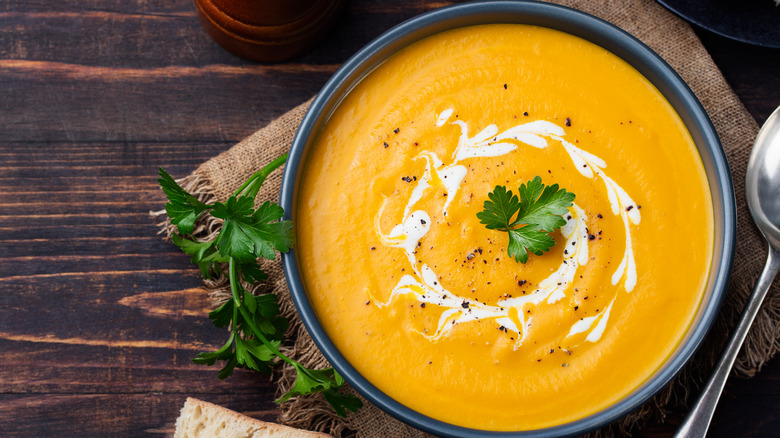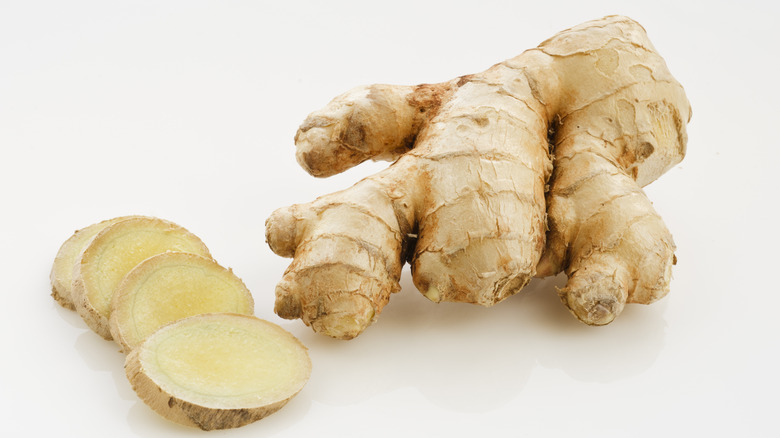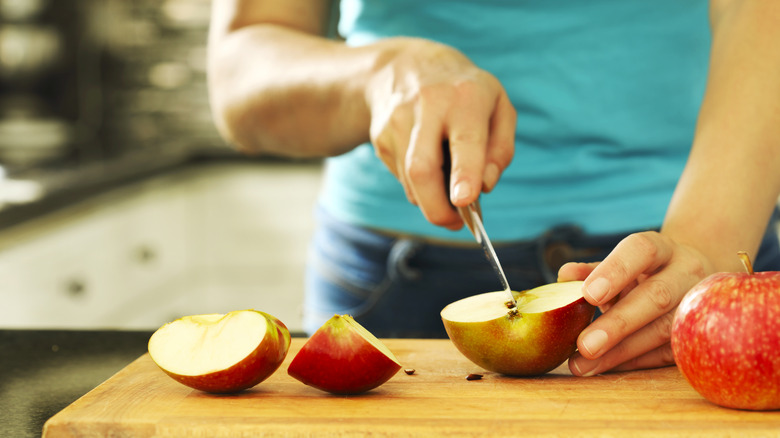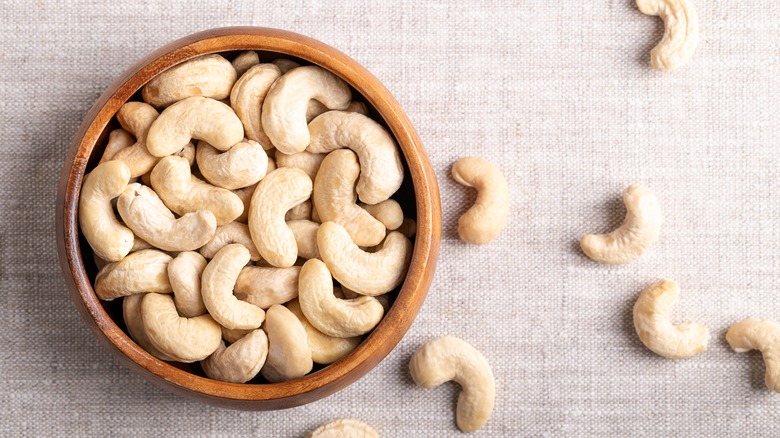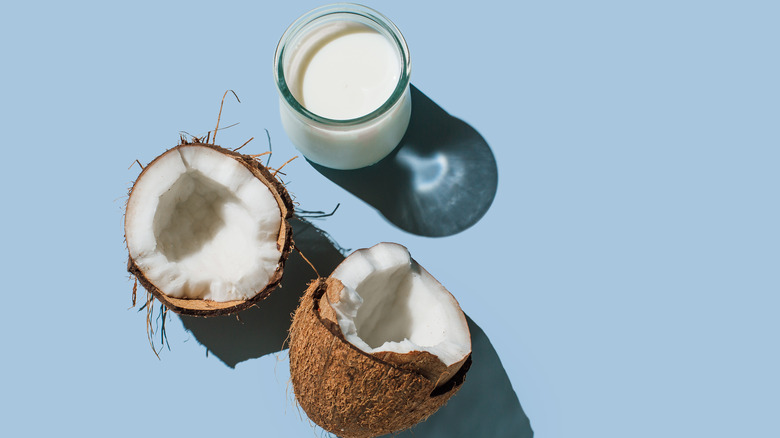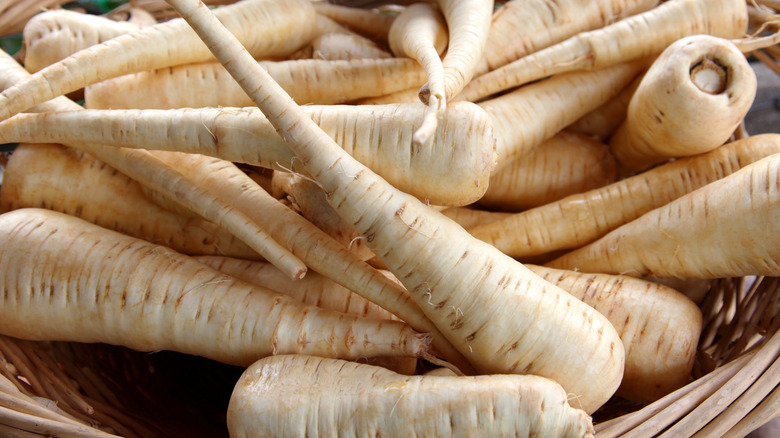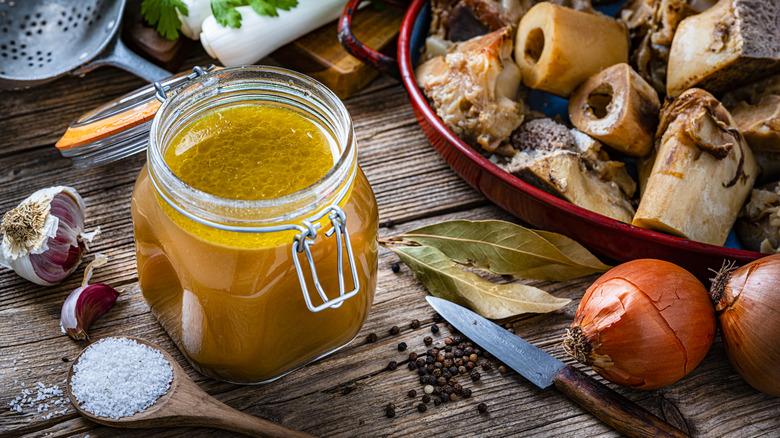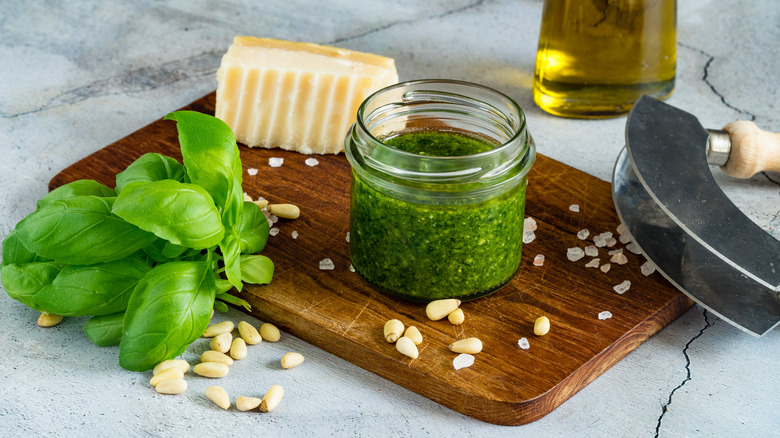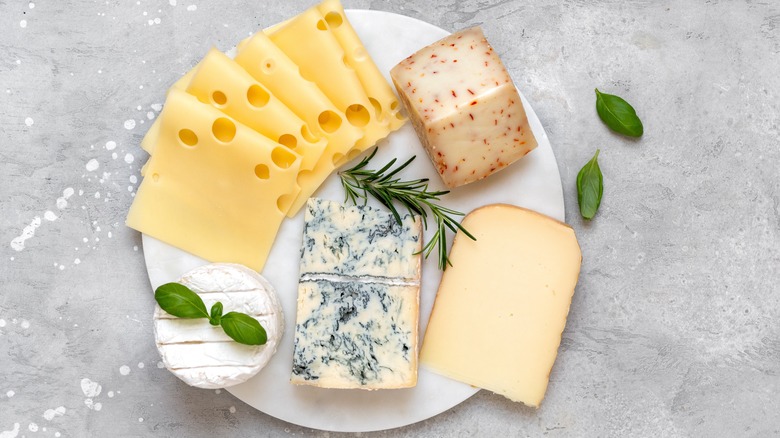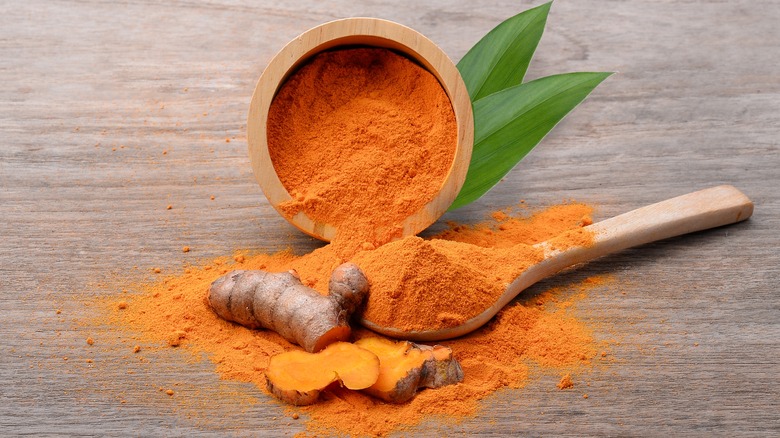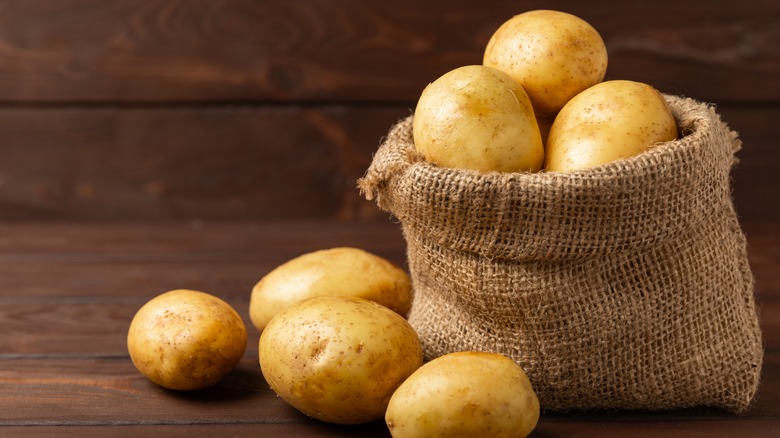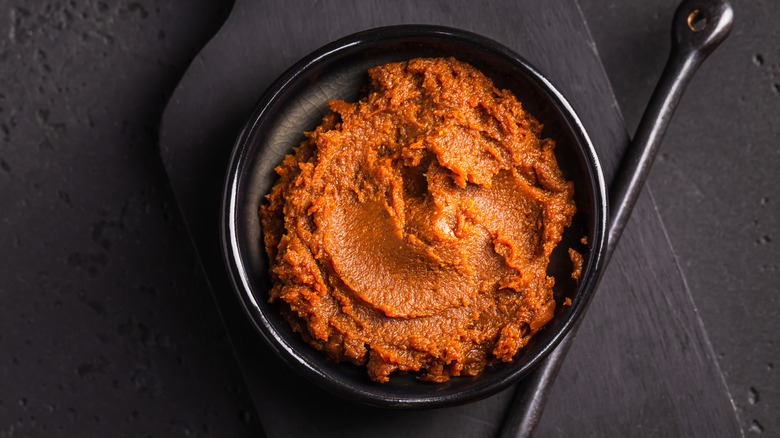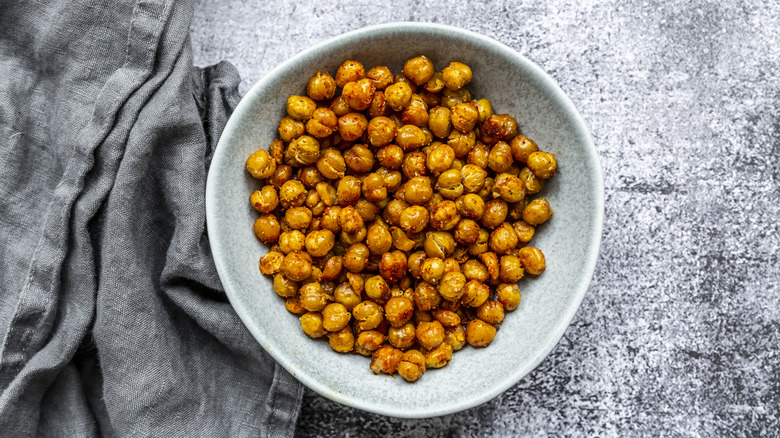14 Ways To Upgrade Your Carrot Soup
Carrot soup is one of the rare dishes that is both a health food and a comfort food. Serve it with buttered toast or a salad and you'll have a well-rounded meal that will leave you feeling nourished rather than stuffed. There are many reasons to eat more carrots. Just one medium sized carrot contains a whopping 110% of the recommended daily intake of vitamin A, which helps boost the immune system and strengthen eye health. Other excellent sources of the vitamin include liver, oily fish, and cheese, but carrots have the additional benefit of being extremely low in calories (we're talking about 30 calories each). If you're trying to stock up on vitamin A but are also trying to cut back on calories, carrots are the perfect option.
Soup is one of the best ways to sneak this vitamin-rich veggie into your diet without sacrificing indulgence. All you need to make a basic recipe is carrots, a type of liquid (usually broth), salt, pepper, and a blender. Simply cook the carrots in the liquid, season it to taste, and blend the mixture into a smooth consistency. Many recipes use cream to make the broth richer and more filling, and there is no shortage of other ingredients you can add that will take the recipe to the next level. We've rounded up some of our favorite options that will keep you craving this nutrient powerhouse no matter how many times you've made it.
1. Roast the carrots
One of the most delicious carrot soup upgrades requires no new ingredients — all you have to do is roast the carrots. This cooking method brings out the earthy sweetness of the root vegetable, adding depth to an already delicious flavor and bringing a touch of autumnal richness to the dish.
Although the extra cooking step requires a little more time, our recipe for roasted carrot soup keeps things simple and healthy. All you need are carrots, onion, olive oil, oregano, salt, pepper, garlic powder, chicken broth, and a bay leaf. If you're vegetarian, a vegetable-based broth will work just as well. To make it, you'll start by roasting the carrots and onions seasoned with oregano, salt, pepper, and garlic powder on low heat (320 degrees Fahrenheit). Then, transfer everything to a pot with the broth and a bay leaf and let it simmer for five minutes before blending it. The result is a smooth, sweet, vitamin-rich dish that is perfect for lunch or a light dinner. Despite the extra time required for roasting the carrots and onions, this recipe only takes 45 minutes from start to finish, and if you make a little extra, you'll have enough for leftovers.
2. Add ginger
Carrots and ginger go together like apples and cinnamon. There is just something about this sweet, earthy, warming combination that makes your taste buds soar. Especially as the weather starts to turn toward sweater season, combining these ingredients into a bowl of soup will hit the spot.
This carrot ginger soup recipe from Tasting Table starts with roasting the carrots and an onion for 20 minutes before simmering them in a seasoned broth. With 1 teaspoon of minced ginger per pound of carrots, the spiciness is subtle, letting the sweet earthiness of the roasted veggies shine.
Our recipe for silky smooth carrot and ginger soup opts for a bolder flavor even though the carrots are not roasted first. In addition to onion, it calls for 3 cloves of garlic per 2 pounds of carrots, juice from half a lemon, and a whole tablespoon of freshly grated ginger. The result is savory and sweet from the combination of garlic and carrots. The ginger adds an unmistakable heat, while the fresh squeeze of lemon brightens the flavor. Make sure to add the lemon after you've blended the soup and are about to serve it. Cooking the citrus for too long can make it bitter, and it can even turn the carrot's brilliant shade of orange to a dull brownish color.
3. Add apples
Apples and soup might not sound like an obvious combination, but trust us, it works. The sweetness in both ingredients fit seamlessly together, and the results are even more delicious than a plain carrot soup. If you're worried about ending up with a sweet soup, rest assured that this silky carrot apple soup recipe from Tasting Table produces something that is unmistakably savory. The sugary central ingredients are combined with leeks, celery, fresh ginger, and herbs to create a dish that is full of complex flavor. Sweet and savory with a pleasantly grassy flavor from the celery and warmth from the ginger, this soup is perfect for any time of the year, whether you're cozying up to a fire or looking for a refreshing lunch on a sunny summer afternoon.
Start by sautéing the leeks, celery, and ginger before adding the carrots, apples, sage, and thyme. Simmering the mixture for 30 minutes and then letting it sit for another half hour ensures that the veggies are steeped in flavor and so soft you could almost get away with not blending them at all.
4. Use nuts instead of cream
If you're looking for a way to make your carrot soup rich and creamy without loading it up with saturated fats in the form of cream, look no further than a bag of cashews. Beloved as a snack, these nuts also make the perfect alternative to dairy when blended into soups, dips, and desserts. You can even use them to make a delicious homemade cashew coffee creamer.
This vegan carrot cashew soup recipe from Tasting Table is a prime example of how miraculously this type of nut transforms into a dairy substitute. After cooking the rest of the ingredients, you'll blend the cashews until they form a smooth butter-like consistency and then add everything else to the blender. You could get away with little more than carrots, broth, salt and pepper, and cashews, but this recipe goes the extra mile. Roasting the carrots gives them a caramelized sweetness, while the addition of cumin, coriander, and lemon give the soup a pop of flavor.
5. Make it creamy with coconut milk
Coconut milk might not be any healthier than dairy-based cream, but it does add another dimension of flavor. In fact, coconut milk is a total game-changer for texture, too, especially when making eggs. In soup, it provides next-level silkiness and that trademark coconut flavor that somehow manages to taste divine with any ingredient combination. Sweet, savory, or somewhere in between, there are no shortage of recipes that taste better with this versatile ingredient.
You can incorporate coconut milk into a carrot soup recipe in various ways. If you're roasting the carrots first, you can simply transfer them to a blender and use the coconut milk instead of the standard broth. If you aren't planning to roast the carrots first, you can simmer them in the coconut milk to add even more richness and flavor to the vegetable. If you want to keep the soup light and only want a hint of creamy coconut texture and flavor, follow a carrot soup recipe that uses broth (vegetarian or otherwise) and add coconut milk to the blender to taste. For this option, make sure to leave some of the broth behind so the soup doesn't end up being too thin.
6. Add a crunchy garnish
No matter what ingredients you add to carrot soup, they will take on the same texture as everything else once they've been thrown in the blender. Sometimes, a silky smooth soup hits the spot, but adding a bit of textural variation can elevate the dish with little effort and make it seem like more of a main dish than a side dish. For soup, nothing beats a crunchy garnish, and luckily, there are options to suit every craving.
To bulk up the soup and make it more filling, roasted nuts and seeds are an ideal option. Cashews will provide a buttery smoothness, while pepitas and sunflower seeds will offer a roasted flavor and satisfying crunch. Slivered almonds, chopped pecans, and hazelnuts are also delicious.
For something less filling but equally crunchy, try fried onions. They are readily available at the grocery store and offer a hint of salty indulgence. If you don't have any in your pantry and don't feel like running to the store, swap fried onions with crushed potato chips. They might not be the most conventional of soup garnishes, but they might become your new go-to. Last but not least, why not opt for croutons? This classic soup garnish is crunchy, buttery, and filling, and we've got the best homemade crouton recipe that is quick to make and unrivaled by any store-bought options.
7. Add parsnips
Instead of looking for contrasting ingredients to add to carrot soup, opt for something complementary, like parsnips. Although they are shaped like carrots and also happen to be a root vegetable, they offer a subtly different flavor and texture. Where carrots are sweet and have an almost floral scent, parsnips have a hint of spiciness and an undertone of nuttiness. They are also more starchy, meaning that they add more creaminess to soup than their orange counterparts. Where carrots are 88% water (even more than apples) parsnips are a little over 79% water, about as much as a potato.
This roasted carrot and parsnip soup from Tasting Table provides the roadmap for making a harmonious combination of the root vegetables. With lots of garlic, fresh ginger, and sage, it is full of flavor that elevates the carrots and parsnips even further. It also contains a hefty dose of cream, turning this healthy soup into a (still healthy) indulgence. Because of the cream and added starch from the parsnips, this carrot soup makes a whole meal in itself, though a side salad or a loaf of crusty buttered bread wouldn't hurt.
8. Swap vegetable broth with bone broth
Most carrot soup recipes call for some type of broth to simmer the carrots in, or, if the carrots are roasted, to provide the liquid base for blending. There are many options to choose from, but if you want to take your soup to the next level in flavor as well as nutrition, bone broth stands head and shoulders above the rest.
There's no question that you should start keeping bone broth in your pantry at all times. While many broths are made with just meat, bone broths are made — you guessed it — with bones. This essential ingredient actually makes bone broth a stock, but you're more likely to find it labeled as broth (alliteration beats accuracy every time). All you have to do to make it is simmer water and bones for a minimum of four hours, preferably much longer. Adding veggies and seasonings will improve the flavor, but they aren't mandatory for nutritional value.
Bones are full of collagen, which is one of the main types of protein in the body and provides multiple health benefits. It lessens joint pain, reduces inflammation in the gut, and strengthens bones. If you plan to make the stock yourself, be sure to read about the best bones to use for broth. If you plan to buy it, make sure to check out our rundown of the best store-bought bone broths.
9. Add a spoonful of pesto
One of the biggest selling points of carrot soup, aside from its flavor and nutritional value, is its appearance. A vibrantly colored meal is much more attractive than one that is different shades of beige, and anything that puts carrots front and center is on the right track. However, if you want to make the dish even more striking, a dollop of pesto will provide a pop of color to make your creation look like art. As if that weren't enough, pesto also provides a pop of flavor. With the subtle sweetness of the carrots, it adds a spicy, garlicky note that transforms the recipe without robbing it of its signature earthy sweetness.
Pesto is readily available to purchase, but it's almost always tastier when you make it at home. It's even one of the reasons why you should stop throwing away your carrot tops. Instead of using just basil in your pesto, throw in some of the green fronds sprouting from the top of the carrots to provide an extra dose of iron, calcium, and color to the dish.
10. Make it cheesy
Whenever you're trying to liven up a savory recipe, cheese should be the first port of call. It's such an easy and delicious addition that it almost feels lazy, but hey — if it works, why not take advantage? Carrot soup tastes particularly delicious with a cheesy garnish because its earthy, sweet flavor is practically crying out for a tangy, umami-rich contrast. You don't want to overload it, but a subtle sprinkling makes all the difference.
There are many options when it comes to adding cheese to carrot soup. You could opt for the classic nutty tanginess of Parmesan, choose something melty and gooey like cheddar, or go for something that has even more sharpness with crumbled feta. If you really want to feature the cheesy element, add a whole ball of burrata to each bowl. It won't make it a low-calorie meal, but it will be filling and oh-so-delicious. If you'd rather not put the cheese directly in the soup, you can always make grilled cheese to go on the side.
11. Mix in warming spices
Adding spices is an easy way to inject a kick of flavor into an otherwise mild recipe. It also gives you plenty of territory to tailor the dish exactly to your tastes. Like an artist mixing paints, you can add a hint of this and a dash of that until you find exactly the flavor you're looking for. Warming spices are the most popular category to add to carrot soup. Cumin and ginger, for example, bring out the earthiness of the sweet vegetable, providing depth and a bit of heat. To take it up a notch, add some pepper. You could opt for a pinch of red pepper flakes as a garnish in each bowl, or stir some cayenne pepper into the blender.
Another popular option is turmeric. Like pesto, it provides color, but instead of giving the carrots contrast, it simply dials the orange hue up a few notches. Stirring in some cream or coconut milk along with the turmeric will make your soup a beautiful pastel orange while adding to the flavor.
12. Add potatoes
Like parsnips, potatoes add starch to carrot soup, ensuring that you don't need to rely on fatty ingredients to make it creamy. Unlike parsnips, however, potatoes have a much more subtle flavor, resulting in a soup that is mildly sweet and earthy, closer to a cream of potato soup than a sweet, earthy carrot soup. You can adjust the ratios so that the carrot flavor is more pronounced, but the combination of these root vegetables is delicious no matter how much of each you use.
This fall vegetable soup recipe from Tasting Table showcases their potential, and adds a third element — butternut squash. With one large potato, two large carrots, and half a butternut squash, the vegetables are evenly represented, creating a seamless flavor that is even more than the sum of its parts. Nutty, earthy, sweet, and creamy, it is the perfect fall or winter recipe. In addition to the root vegetables, it calls for an onion and a leek, which add a savory dimension to the proceedings. Serve it with fresh bread and you'll be in soup heaven.
13. Add miso
Miso is such a versatile ingredient that it could be put in just about any savory recipe. The fermented soybean paste is known for its pure, powerful umami flavor, an element that instantly deepens and elevates a recipe, even when it isn't identifiable. Unless a dish is specifically meant to taste like miso (such as miso soup), the paste shouldn't be detectable. Instead, your dinner guests will simply be marveling over the flavor and asking you for your cooking secrets.
Carrots are a root vegetable, but their earthy flavor is usually overpowered by their sweetness. A subtle touch of miso balances it out instead of calling attention to itself the way onion or garlic would. You only need about half a tablespoon per serving, but keep in mind that different types of miso have different strengths. White miso is the mildest, while red miso, which has been fermented longer, has the most powerful flavor. It will also add saltiness to the recipe, so make sure not to add salt to the soup until the very end when you can determine exactly how much you need.
14. Top it with roasted chickpeas
Carrot soup is a light dish that will usually need to be served with a hearty salad or grilled cheese sandwich to make a complete meal. However, there is an ingredient you can add as a garnish that will turn it into a complete meal: chickpeas. But not just any chickpeas. Sure, you could stir in some plain, steamed chickpeas and call it a day, but it wouldn't add much to the texture, and the flavor of these legumes is even more subtle than the flavor of carrots. For the best results, roast the chickpeas with plenty of seasonings.
You can use pretty much any spice and herb combination you like. Garlic powder and salt are a surprisingly satisfying combo, while a premixed za'atar or Moroccan seasoning will add more dimension. For a bit of heat, look no further than this spicy roasted garbanzo bean recipe. With equal parts onion powder, garlic powder, black pepper, paprika, cumin, and salt, the results are bursting with flavor and provide the perfect crunchy garnish for your soup.
